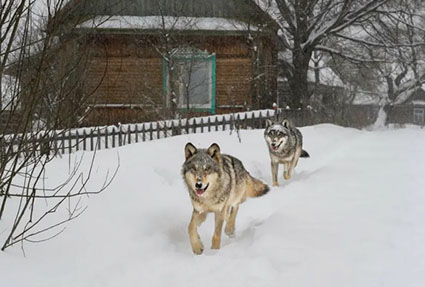by WorldTribune Staff, February 12, 2024
In the nearly 38 years since the nuclear disaster at Chernobyl, wildlife have reclaimed the area and some appear to be unaffected by chronic exposure to radiation.

Packs of mutant wolves who inhabit the human-free Chernobyl Exclusion Zone (CEZ) “have developed cancer-resilient genomes that could be key to helping humans fight the deadly disease,” according to a study.
With the dissolution of the Soviet Union in 1991, Chernobyl remained part of Ukraine within the CEZ, which Ukraine inherited from the Soviet Union.
Cara Love, an evolutionary biologist and ecotoxicologist in Shane Campbell-Staton’s lab at Princeton University, has studied how the wolves of Chernobyl survive and thrive despite generations of exposure and the accumulation of radioactive particles in their bodies.
The Society of Integrative and Comparative Biology noted: “Love and colleagues went to the CEZ, radio-collared wolves, and took blood to understand the wolves’ responses to cancer-causing radiation. Using these specialty GPS collars armed with radiation dosimeters,’we get real time measurements of where they are and how much [radiation] they are exposed to,’ said Love. They discovered that Chernobyl wolves are exposed to upwards of 11.28 millirem of radiation everyday for their entire lives, over 6 times the legal safety limit for the average human worker.
“Unlike wolves living exclusively outside the CEZ, Love found that Chernobyl wolves have altered immune systems, similar to cancer patients undergoing radiation treatment. And most promising, she has identified specific regions of the wolf genome that seem resilient to increased cancer risk. Most human research has found mutations increasing cancer risk.”
The research could be key to examining how gene mutations in humans could increase the odds of surviving cancer — flipping the script on many known gene mutations, like BRCA, that cause cancer.
Chernobyl dogs — the descendants of former residents’ pets — may also possess similar cancer resilience, though they haven’t been studied the same way as their wild cousins.
Humans abandoned the area after the explosion leaked cancer-causing radiation into the environment, and a 1,000-square-mile zone was roped off to prevent further human exposure.
The findings are especially valuable as scientists have learned that canines fight off cancer more similarly to the way humans do than lab rats.
Love’s work has stalled somewhat as she and her colleagues have been unable to return to the Chernobyl Exclusion Zone — first due to the Covid pandemic, and now due to the ongoing war between Russia and Ukraine.
Quality Resource for Citizen Journalists
